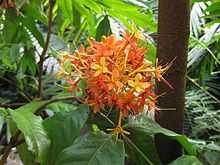Saraca
| Saraca | |
|---|---|
 | |
| Saraca indica | |
| Scientific classification | |
| Kingdom: | Plantae |
| (unranked): | Angiosperms |
| (unranked): | Eudicots |
| (unranked): | Rosids |
| Order: | Fabales |
| Family: | Fabaceae |
| Subfamily: | Caesalpinioideae |
| Tribe: | Detarieae |
| Genus: | Saraca L. |
| Species | |
|
Saraca asoca (= S. indica) | |
Saraca L. is a genus in the family Fabaceae (legume family) of about seventy plant species of tree native to the lands from India, China and Ceylon to Malaysia and Celebes.
The trees are grown in distinctly warm humid climates, and prefer a moist well-drained soil with plenty of organic matter. They can also be grown within greenhouses. The trees themselves are grown for their upturned flowers which have clusters in yellow, orange or red. The trees' flowers have no petals, but contain brightly colored sepals, and have stamens projecting up to eight inches long. The leaves are pinnate and have paired leaflets. Typically, these trees are accustomed to the shade of other trees. Most species of Saraca are trees characteristic of particular streams. The species Saraca asoca is believed to be the tree under which Buddha was born. Red saraca is the provincial tree of Yala province, Thailand.
Pests
S. indica is host to the Peacock mite Tuckerella channabasavannai.
References
- De Wilde, W. J. J. O. (1985). Saraca tubiflora, A New Species from West-central Sumatra (Caesalpinioideae). Blumea 30: 425-428.
- Hooker, Joseph Dalton. (1879). The Flora of British India, Vol II. London: L. Reeve & Co.
- Mabberley, D. J. (1987). The Plant Book: A Portable Dictionary of the Higher Plants. Cambridge: Cambridge University Press. ISBN 0-521-34060-8.
- Blaxell, D., Bryant, G., Francis, F., Greig, D., Guest, S., Moore, J., North, T., Paddison, V., Roberts, S., Rodd, T., Scholer, P., Segall, B., Stowar, J., Walsh, K. (2001) "The Firefly Encyclopedia of Trees and Shrubs." Willowdale, Ontario: Firefly Books Ltd. ISBN 1-55209-603-3.